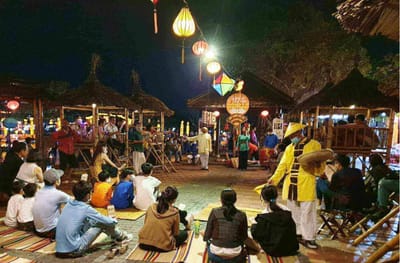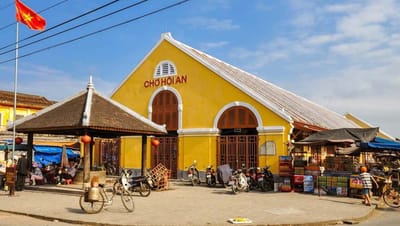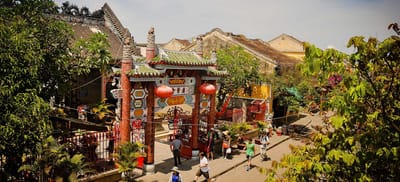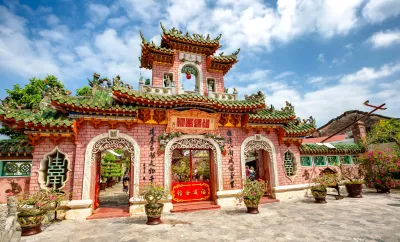Hoi An Lantern Festival 2025: Dates, Traditions & Guide

Executive Summary
Festival Essentials: The Hoi An Lantern Festival, officially called "Hoi An Legendary Night," occurs monthly on the 14th lunar day when electric lights dim and 10,000+ silk lanterns illuminate the ancient town. The 2025 dates are: Jan 13, Feb 11, Mar 13, Apr 11, May 11, Jun 9, Jul 8, Aug 7, Sep 5, Oct 5, Nov 3, and Dec 3. From 6:00–10:00 PM, the UNESCO heritage core transforms into candlelit atmosphere featuring traditional music (Bài Chòi folk games, Bội singing), ancestral worship rituals, vegetarian street food, floating lantern releases on the Thu Bon River, and cultural performances. February's festival (first full moon after Tet) attracts the largest crowds. Entry to the ancient town requires no special ticket beyond the standard heritage pass. The monthly event balances Buddhist full moon traditions with 1990s tourism innovation, creating Hoi An's signature evening experience.
The Hoi An Lantern Festival represents Vietnam's most photographed monthly cultural event—a deliberate fusion of ancient Buddhist full moon worship with contemporary heritage tourism that has defined Hoi An's identity since 1998. Understanding the festival's historical roots, practical logistics, and cultural significance transforms a simple evening visit into meaningful participation in living Vietnamese traditions.
Historical Origins: From Buddhist Ritual to Tourism Icon
The Full Moon Tradition
Long before Hoi An created its lantern-focused festival, Vietnamese Buddhists honored the full moon as sacred time. Buddhist theology holds that significant events in Buddha's life—his birth, enlightenment, and death—occurred during full moons, making the 14th and 15th lunar days spiritually potent for meditation, merit-making, and ancestral offerings.
Vietnamese families traditionally observed these nights by visiting pagodas, burning incense, presenting fruit and flower offerings at ancestral altars, and abstaining from meat (vegetarian meals honor spiritual purity). This practice, common throughout Vietnam, continues today as genuine religious observance rather than performance for tourists.
The Lantern Legacy
Hoi An's lantern tradition traces to 16th-century Chinese and Japanese merchants who introduced decorative silk and paper lanterns during the town's golden age as Southeast Asia's major trading port. Lanterns symbolized prosperity and good fortune—wealthy merchant families competed to display the most elaborate designs, creating the colorful streetscape that survived centuries.
Lantern-making declined during the Vietnam War but resurged vigorously in the 1990s as Hoi An pivoted toward heritage tourism. Local craft families revived traditional techniques, and by 1998, an estimated 10,000+ silk lanterns hung throughout the ancient town year-round.
The 1998 Innovation
In 1998, Hoi An authorities conceived a creative synthesis: combine the Buddhist full moon tradition with the town's lantern iconography to create a monthly tourism event called "Reenactment of Hoi An Legendary Night in the Early 20th Century". The concept aimed to recreate pre-electricity Hoi An—when only candlelight and lanterns illuminated evening streets.
The innovation succeeded beyond expectations. Within years, the monthly Lantern Festival became Hoi An's most recognizable tourism product, attracting thousands of domestic and international visitors who specifically time visits to coincide with the 14th lunar day. In 2023, Vietnam recognized the festival as national intangible cultural heritage, cementing its cultural legitimacy beyond tourism marketing.
[Link to: Hoi An at Night: Evening Activities for comprehensive evening planning context]
2025 Festival Dates & Calendar
The Lantern Festival follows the lunar calendar, occurring on the 14th day of each lunar month when the moon reaches near-fullness (technically, the full moon peaks on the 15th, but the 14th offers brighter evening moonlight as festivities begin at sunset).
Complete 2025 Schedule
| Month | Lunar Date | Gregorian Date | Special Notes |
|---|---|---|---|
| January | 14th of 1st lunar month | January 13, 2025 | First festival of year |
| February | 14th of 2nd lunar month | February 11, 2025 | LARGEST CROWDS (post-Tet full moon) |
| March | 14th of 3rd lunar month | March 13, 2025 | Spring season |
| April | 14th of 4th lunar month | April 11, 2025 | Peak tourism season begins |
| May | 14th of 5th lunar month | May 11, 2025 | Hot season |
| June | 14th of 6th lunar month | June 9, 2025 | Summer solstice period |
| July | 14th of 7th lunar month | July 8, 2025 | Ghost Month begins (Vietnamese tradition) |
| August | 14th of 8th lunar month | August 7, 2025 | Mid-Ghost Month |
| September | 14th of 9th lunar month | September 5, 2025 | Precedes Mid-Autumn Festival |
| October | 14th of 10th lunar month | October 5, 2025 | Autumn season |
| November | 14th of 11th lunar month | November 3, 2025 | Cool season begins |
| December | 14th of 12th lunar month | December 3, 2025 | Year-end celebrations |
PLANNING TIP: February 11, 2025 represents the largest and most elaborate celebration—the first full moon after Lunar New Year (Tet). Vietnamese families celebrate with particular enthusiasm, creating maximum cultural atmosphere but also peak crowding. For authentic experience with manageable crowds, consider March, May, or November dates
How to Verify Dates
Lunar calendars shift relative to Gregorian dates annually. To confirm future festival dates:
- Check Vietnamese lunar calendar converters online
- Count to the 14th day of any lunar month
- Monitor Hoi An official tourism websites for announcements
- Ask your hotel reception to confirm the next festival date upon arrival
Most sources provide consistent 2025 dates, though minor discrepancies appear due to timezone calculations. The dates listed above represent the consensus across official Vietnamese tourism sources.
![Alt text: Hoi An Ancient Town during Full Moon Lantern Festival with thousands of colorful silk lanterns hanging over yellow shophouses, crowds of visitors in traditional Vietnamese ao dai releasing floating candle lanterns onto the dark Thu Bon River beneath the illuminated Japanese Covered Bridge at night]
What Happens During the Festival
The Lights Go Out (Around 6:00–6:30 PM)
As sunset approaches on the 14th lunar day, a transformation begins. Shop owners, restaurant managers, and municipal authorities gradually dim or extinguish electric lights throughout the ancient town core. Street lamps turn off, neon signs darken, and fluorescent bulbs cease glowing.
In their place, thousands of silk lanterns light up—red, yellow, orange, green, blue, and multi-colored globes hanging at varying heights create layered illumination. Candles placed in paper or glass holders line sidewalks, windowsills, and doorways. The effect transforms Hoi An from well-lit heritage site into atmospheric candlelit village reminiscent of pre-electricity eras.
The lighting transition happens gradually rather than dramatically. By 7:00–7:30 PM, the ancient town reaches full "legendary night" atmosphere—soft, warm, romantic illumination replacing harsh modern lighting.
Traditional Cultural Activities (7:00–9:30 PM)
The festival features performances and participatory activities reviving early 20th-century Hoi An cultural practices:
Bài Chòi Folk Game (UNESCO Intangible Cultural Heritage)
Interactive game combining singing, poetry, and bingo-style card play. A master singer performs verses hinting at card symbols while players compete for prizes. Held at An Hoi Sculpture Garden, Hoai River Square, and the Japanese Bridge area.
Bội Singing
Classical opera-style performances featuring elaborate costumes, stylized movements, and traditional narratives. Usually staged at designated performance areas along Tran Phu Street.
Traditional Music Ensembles
Family groups and cultural clubs perform classical Vietnamese instruments—đàn tranh (16-string zither), đàn bầu (monochord), sáo trúc (bamboo flute), and percussion. Music drifts through pedestrian lanes, creating ambient soundscape.
Calligraphy Demonstrations
Master calligraphers write blessings and poetry in traditional Vietnamese and Chinese script. Visitors can commission personalized works (small fee).
Folk Games
Pot-breaking (blindfolded participants attempt to smash clay pots with sticks), Chinese chess, and other traditional entertainments occur at various locations.
Lion Dances
Colorful lion costume performances with drum accompaniment wind through main streets, bringing luck and chasing evil spirits.
Ancestral Worship & Offerings (Throughout Evening)
Festival nights hold deep spiritual significance for Vietnamese families. Visitors witness authentic religious practices:
Home Altars
Families arrange fruit offerings (oranges, bananas, dragon fruit), flowers, incense, and candles on ancestral altars. These offerings honor deceased relatives, inviting ancestors to share in the full moon blessing.
Fake Money Burning
Vietnamese burn elaborate paper replicas of money (including million-dong bills), houses, cars, phones, and other possessions. The practice stems from belief that ancestors in the afterlife need the same material goods as the living. The items transform to spiritual realm through burning.
Pagoda Visits
Devout Buddhists visit temples and pagodas (Quan Cong Temple, Phuc Kien, Trieu Chau, Quang Trieu) to present offerings, burn incense, and pray for prosperity, health, and family harmony.
These religious observances are genuine cultural practices, not staged performances. Photographers and observers should maintain respectful distance and avoid flash photography during ceremonies.
Floating Lantern Releases (Peak 7:30–9:00 PM)
The festival's most participatory and photogenic activity involves releasing flower-shaped lanterns onto the Thu Bon River—a ritual combining Buddhist prayer with visual spectacle.
The Ritual:
- Purchase biodegradable paper/silk lantern with candle (20,000–30,000 VND) from riverside vendors
- Light the candle while making a silent wish for luck, health, love, or ancestor blessings
- Gently place the illuminated lantern on the river's surface
- Watch it drift downstream with hundreds of others, creating a galaxy of moving lights on dark water
Vietnamese believe lanterns carry prayers and wishes downstream to the sea, where they reach the spiritual realm. The practice brings good fortune while symbolically releasing worries and negative energy.
Best Release Locations:
- Bach Dang Street riverfront (most popular; expect crowds)
- An Hoi Bridge area (good vantage point for photographing others' releases)
- Quieter sections east of Japanese Bridge (fewer people, same ritual)
During festival nights, the Thu Bon River becomes covered with thousands of floating candle lanterns, their collective glow creating one of Vietnam's most photographed scenes.
[Link to: Floating Lanterns Experience for detailed ritual guidance, cultural significance, and photography techniques]
Vegetarian Food Tradition
Full moon Buddhist observance traditionally includes vegetarian meals honoring spiritual purity and compassion for living beings. Festival nights see street food vendors offering special vegetarian versions of Hoi An specialties:
- Vegetarian cao lầu (Hoi An noodles with tofu replacing pork)
- Vegetarian bánh xèo (rice pancakes with mushrooms and vegetables)
- Bánh trung thu (mooncakes with sweet lotus or red bean paste)
- Fresh spring rolls (gỏi cuốn) with vegetables and tofu
- Sweet soups (chè) made with beans, coconut, and tropical fruits
These vegetarian offerings appear alongside regular meat-based street food, giving visitors culinary variety while participating in Buddhist tradition.
Photography & Viewing Strategies
Optimal Locations
Japanese Covered Bridge (West Approach)
The bridge's LED lighting system activates at dusk, cycling through blue, green, yellow, and red illumination. The west side offers frontal compositions with lantern-framed foreground. Arrive before 6:30 PM to secure position before crowds intensify.
"Golden Triangle" (Cargo Club Area)
Intersection of Tran Phu, Bach Dang, and Nguyen Thai Hoc streets features Hoi An's densest lantern concentration. Elevated restaurant balconies (Cargo Club, Tam Tam Café) provide overhead perspectives; book tables in advance.
An Hoi Bridge Mid-Point
Pause halfway across the pedestrian bridge for panoramic views: ancient town lanterns behind, Thu Bon River with floating lanterns below, night market lights ahead. Less crowded than riverfront ground level.
Riverfront Viewing Areas
Bach Dang Street along the river offers unobstructed water views for capturing floating lantern releases. Position yourself north or south of main crowds for cleaner compositions.
Camera Settings & Timing
Blue Hour (6:00–6:30 PM):
Optimal photography window when twilight ambient light balances with lantern glow. Camera settings: ISO 400–800, f/4–5.6, 1/30–1/60 sec (use tripod for sharper results).
Full Dark (7:30–9:00 PM):
Peak lantern activity but challenging exposure. Increase ISO to 1600–3200, shoot wide open (f/1.8–2.8 if possible), accept some motion blur. Bracket exposures for difficult lighting.
Flash Considerations:
Avoid flash during religious ceremonies and performances. For lantern portraits, use fill flash at low power (-1 to -2 EV) to light faces while preserving ambient lantern glow.
Crowd Management
Festival nights attract 5,000–15,000+ visitors (February can exceed 20,000). Strategies for manageable experience:
Arrive Early (5:30–6:00 PM):
Secure restaurant seating, photography positions, and lantern purchase before peak crowds. Witness the lighting transition as an added benefit.
Explore Periphery:
Main thoroughfares (Tran Phu, Bach Dang) become packed 7:00–9:00 PM. Side lanes (Le Loi, Cong Nu Ngoc Hoa, Phan Boi Chau) offer quieter lantern experiences with fewer people.
Late Evening (After 9:30 PM):
Crowds thin significantly while lanterns remain illuminated. Photographers capture cleaner compositions; romantic couples enjoy peaceful walks.
Alternative Perspective:
Book sampan boat rides (100,000–150,000 VND per person) for water-level views away from pedestrian congestion. Boat operators row gently among floating lanterns.
[Link to: Hoi An at Night: Evening Activities for overall evening planning including festival nights]
Practical Festival Planning
Entry & Tickets
Ancient Town Access:
The Lantern Festival requires no special admission beyond Hoi An's standard Old Town heritage ticket (120,000 VND granting access to 5 heritage sites). If you only walk streets without entering buildings, technically no ticket needed, though enforcement varies.
Heritage Site Hours:
Most ticketed ancient houses, assembly halls, and museums close by 5:30–6:00 PM, before festival activities begin. Focus on outdoor street experience rather than interior site visits during festival nights.
Free Activities:
Walking streets, watching performances, witnessing religious ceremonies, photographing lanterns, and enjoying atmosphere cost nothing. Only floating lantern releases (20,000–30,000 VND) and dining require spending.
Transportation
Pedestrian-Only Hours:
The ancient town bans motorized vehicles during festival evenings (extended pedestrian hours 3:00 PM–10:00 PM). This creates safe, walkable environment but means:
- Taxis/cars cannot enter the core; drop-off at perimeter
- Hotels within ancient town inaccessible by vehicle
- Walking or bicycle only transportation options
Getting There:
Most Hoi An accommodations sit within 1–2 kilometers of the ancient town core. Walk or bicycle from hotels. If staying outside town, arrange taxi drop-off at Central Market, Hoang Dieu ticket booth, or An Hoi Bridge area.
What to Bring
- Comfortable walking shoes (2–4 hours typical festival exploration)
- Cash in small VND denominations (lantern purchases, street food, donations)
- Camera with low-light capability (smartphones work but DSLR/mirrorless cameras capture better lantern glow)
- Portable battery pack (extended photography drains phone batteries)
- Light jacket (evenings cooler than daytime, especially Nov–March)
- Insect repellent (riverfront mosquitoes, particularly rainy season)
- Small bag for purchases (handicrafts, mooncakes, souvenirs)
Accommodation Booking
Festival nights strain Hoi An's accommodation capacity, especially February (post-Tet) and major holidays. Book hotels/guesthouses 2–3 weeks in advance for popular dates. Riverside hotels offer balcony views of floating lanterns but command premium rates and early booking.
Cultural Etiquette & Respectful Participation
Religious Sensitivity
The Lantern Festival blends tourism spectacle with genuine Buddhist observance. Respectful behavior ensures positive cultural exchange:
During Ancestral Ceremonies:
- Maintain respectful distance (2–3 meters) when families perform rituals
- Avoid flash photography of altars and worship
- Do not touch offerings or religious items
- Speak quietly near temples and home shrines
Floating Lantern Releases:
- Purchase lanterns from official vendors (supports local economy)
- Choose biodegradable paper/natural materials over plastic versions (environmental consideration)
- Make your wish silently and mindfully (honor the tradition's spiritual purpose)
- Avoid treating releases as mere photo opportunities; participate with cultural respect
Photography Guidelines
- Ask permission before photographing individuals, especially elderly residents in traditional dress
- Avoid disrupting performances—shoot from sidelines without blocking audiences
- Respect "no photography" signs at specific temples or during certain ceremonies
- Share images responsibly on social media with cultural context, not mockery
Supporting Local Community
- Purchase from family vendors rather than corporate outlets
- Dine at locally-owned restaurants serving traditional cuisine
- Hire local guides for cultural context and storytelling
- Respect residential areas—the ancient town remains a living community, not an open-air museum
Beyond the 14th: Lanterns Year-Round
While the monthly Lantern Festival creates peak atmosphere, Hoi An maintains its lantern character nightly:
Regular Evenings (Non-Festival Nights):
- 10,000+ silk lanterns still illuminate streets every night
- Electric lights remain on (less dramatic than festival blackout)
- Floating lantern releases available nightly (vendors year-round)
- Fewer crowds, more relaxed exploration
- All restaurants, bars, and shops operate normal hours
Festival vs. Regular Nights:
Festival adds: electric light reduction, intensified cultural performances, larger crowds, enhanced ancestral worship visibility, and peak floating lantern activity. Regular nights offer: same visual lantern beauty with less intensity, easier photography, relaxed dining availability, and authentic daily life observation.
First-time visitors benefit from experiencing both: one festival night for cultural immersion and one regular evening for leisurely exploration without crowds.
[Link to: Inside Hoi An Night Market for complementary night market experience]
[Link to: Seasonal Festivals in Hoi An for other annual events and cultural celebrations]
Conclusion
The Hoi An Lantern Festival occupies a unique position in Vietnamese cultural tourism—a monthly event that succeeds in balancing genuine Buddhist tradition with visitor accessibility. The 14th lunar night transforms the ancient town from well-preserved heritage site into living cultural experience where travelers witness authentic religious practices, participate in meaningful rituals, and engage with centuries-old customs.
Understanding the festival's dual nature—both spiritual observance for local Vietnamese and cultural attraction for international visitors—allows appropriate participation. Come with respect for the religious significance underlying the visual spectacle. Release floating lanterns mindfully, recognizing the Buddhist prayer tradition rather than treating it solely as Instagram content. Observe ancestral worship from respectful distance, appreciating the genuine family devotion on display.
The monthly schedule provides flexibility for travelers—align your Hoi An visit with the 14th lunar day for maximum cultural immersion, or explore during regular nights for quieter lantern appreciation. Either way, Hoi An's evening lantern magic defines the town's identity and creates memories that justify the UNESCO World Heritage designation protecting this extraordinary cultural landscape.
No spam, no sharing to third party. Only you and me.






